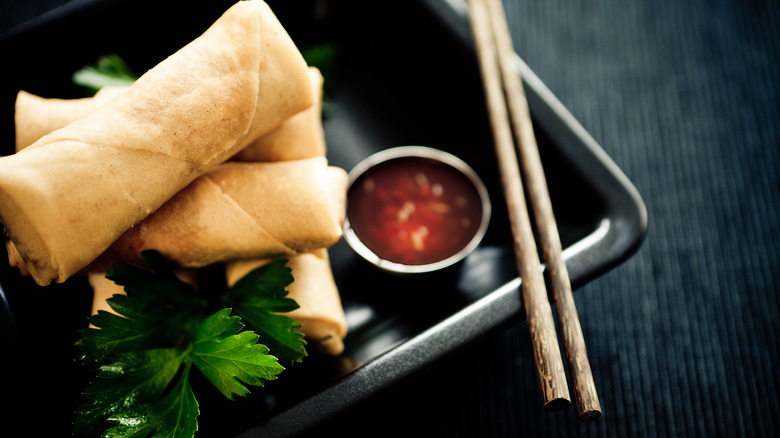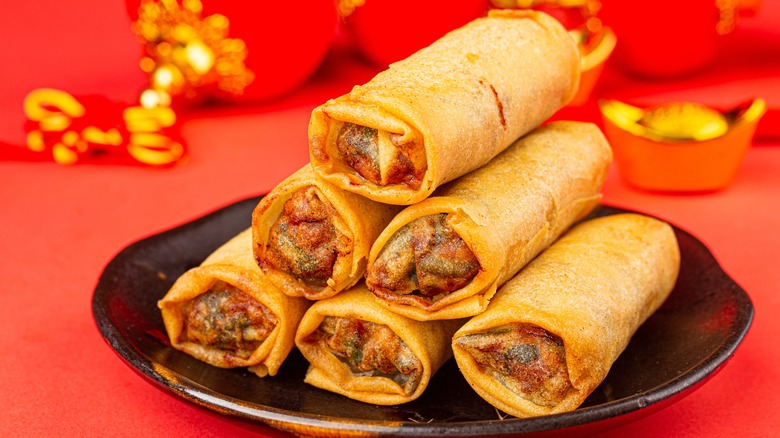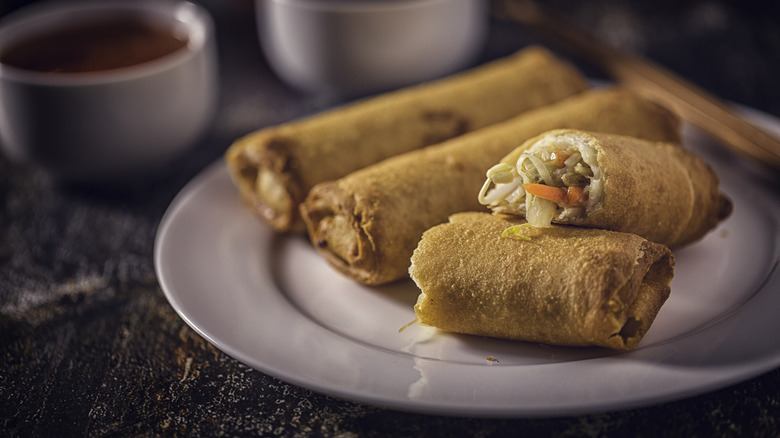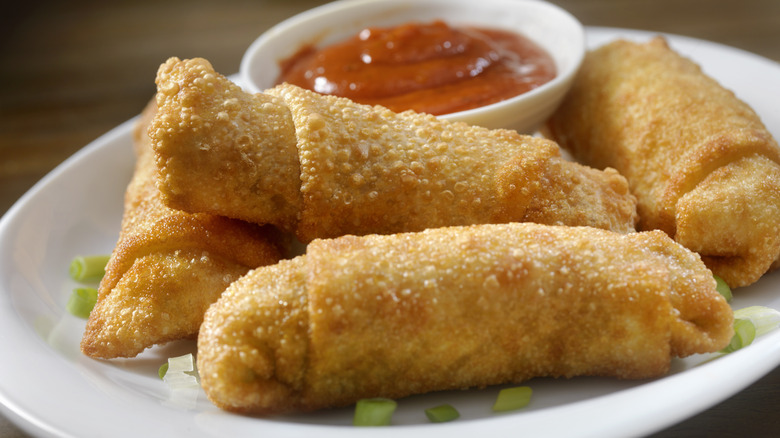The Exact Difference Between Spring Rolls And Egg Rolls
You'll spot spring and egg rolls on the menus of countless restaurants around the world. The principle of each is similar: Filling that's bundled up in a wrapper to make a food roll. But if you have two plates in front of you, and one has spring rolls and the other egg rolls, you'll immediately spot a few differences. For one, the spring rolls will have a thinner wrapper than the egg rolls, with the latter giving you a heartier crunch. And typically, once you've taken a bite out of each one, spring rolls will have a more veggie-focused filling – despite some spring rolls also including meat from time to time. Egg rolls, on the other hand, should have a heartier portion of meat inside.
These are only the most glaring differences between them, though. The two recipes also differ in many other ways — not just in the ways that they're made, but also in their respective histories.
What is a spring roll?
Many countries across Asia, from China to Vietnam to Thailand and the Philippines have their own unique spins on the spring roll. They go by different names and may be prepared differently from one region to another, too. But in the U.S., the one version of the spring roll that's the most popular is the Chinese-style roll. You can find them being sold as appetizers in just about any Chinese restaurant around the country. So, what are they made of?
It's very simple: A basic spring roll has a filling that either contains shredded vegetables, chopped meat, or a mixture of both. The filling is wrapped up with a thin, flour-based wrapper into a thick cylinder. Although spring rolls can be eaten right then, it's very popular for people to further kick it up a notch by deep-frying the rolls. After a few minutes of sizzling in the deep fryer, the soft wrapper turns super crunchy, crackling in the mouth when you bite down into it.
What is an egg roll?
Remember the first time you heard of an egg roll? The odds are good that you probably thought it was some kind of wrap that's made from egg ... in fact, if you've never really looked into the recipe, you probably still think there's egg somewhere in there to this day. Well, funnily enough, there's no egg in an average egg roll at all — not in the filling, and not in the wrap, either.
At the core of an egg roll is shredded cabbage and minced meat. The filling is bundled up using a thick wrapper made from wheat flour into a cylinder. It's then deep-fried to give you that famous crunch. Dip it in soy sauce (with some chili sauce whisked in) or honey mustard, and you're in for quite a treat!
If you're still stuck on why egg rolls have the name they do when they don't actually contain any eggs, there are a lot of theories and debates. But basically, there are two possible explanations. First, since egg rolls evolved from traditional Chinese spring rolls, the word "egg" (蛋, pronounced "ceon") is very similar to the word "spring" in Cantonese, which is also pronounced "ceon" (but written differently as 春.) It's possible that people just mistook one for another and the name stuck. Another explanation theorized that Chinese chefs might've used eggs to make the wrap at an earlier point, and that eggs were eventually taken out of the recipe ... but not out of the name!
The history of the rolls
While both spring rolls and egg rolls are generally seen as Asian recipes, only one of them actually came from Asia: Spring rolls. They've been around since as far back as the third century during the Jin Dynasty. The recipe hasn't really changed much since then: Still the same mixed filling of vegetables and minced meat wrapped up in a thin, pastry-like wrapper. Really, the only difference you'll find between third-century spring rolls and modern ones is that spring rolls nowadays are usually made from processed all-purpose flour or rice paper. These rolls are usually cooked up and stacked on plates during the Chinese New Year feasts that mark the arrival of spring (hence the name "spring rolls.")
In contrast, egg rolls' origins are more recent — and a bit more mysterious. They are believed to have been created by Chinese immigrants in the United States who drew inspiration from traditional spring rolls. The exact origins of egg rolls are uncertain, with little evidence pinpointing the first recipe or creator. However, they first appeared on menus in the New York City area in the 1920s and 1930s. Unlike spring rolls, which were traditionally reserved for special occasions, egg rolls became known as a delectable everyday comfort food option.
Where spring rolls and egg rolls differ
The most notable distinction between the two rolls is undoubtedly the wrapping material. Chefs typically use all-purpose or rice paper to form the wrapper for spring rolls. When fried, the wrapper takes on a golden-brown hue and firms up slightly, resulting in a crunchy and crumbly outer shell. An un-fried version that's wrapped in rice paper exists and is called a summer roll, or gỏi cuốn in Vietnamese. Thanks to the sheerness of the rice paper, you can get a good glimpse at the filling inside. That's why from time to time, people also line the outside of the filling with cooked shrimp to add some color and intrigue to the rolls!
On the other hand, egg roll wrappers are thicker, made from wheat flour, and fortified with cornstarch, which fries more effectively. As mentioned, while both types feature a vegetable filling comprising shredded cabbage, carrots, and mushrooms; egg rolls often boast a heartier filling, sometimes with a greater emphasis on cooked meat than spring rolls.




